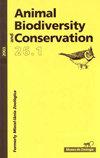西班牙西北部两个自然种群的生长速率:与其他生活史参数的关系
IF 1
4区 环境科学与生态学
Q3 BIODIVERSITY CONSERVATION
引用次数: 0
摘要
我们分析了加利西亚(西班牙西北部)两种三刺鱼(Gasterosteus aculeatus)的自然种群的生长速度,在那里它有严格的年度生命周期。我们使用von Bertalanffy增长模型来估计年龄长度数据集的非线性函数。这些欧洲外围种群达到了该物种已知的最高生长率(von Bertalanffy模型的k为0.4个月1)。使用von Bertalanffy模型参数计算每个种群的瞬时死亡率和繁殖力。加利西亚种群的死亡率比一般观察到的扇骨虫科高2.0-2.3倍。综合死亡率和育性,各种群中成熟雌虫的中间适合度最优值不同。总的来说,与其他被研究的刺鱼种群相比,这些生活史上的差异可以解释为对地中海气候类型的适应。因此,这些在物种范围边缘的种群可能已经适应了独特的环境条件,并且可能对生态学和保护感兴趣。本文章由计算机程序翻译,如有差异,请以英文原文为准。
Growth rates in two natural populations of Gasterosteus aculeatus in northwestern Spain: relationships with other life history parameters
We analysed growth rates of two natural populations of the three–spined stickleback fish, Gasterosteus aculeatus, in Galicia (north–west of Spain) where it has a strictly annual life cycle. We used the von Bertalanffy growth model to estimate nonlinear function for length–at–age data sets. These European peripheral populations reach the highest growth rates (k of the von Bertalanffy model > 0.4 month–1) known for this species. Instantaneous mortality rates and fecundity were computed using von Bertalanffy model parameters for each population. Mortality rates found in Galician populations were 2.0–2.3 higher times than those observed in general for Gasterosteidae. Combining both mortality and fertility, different intermediate fitness optima in each population were obtained for mature females. Overall, these differences in life history compared to other studied populations of sticklebacks can be interpreted as local adaptations to a Mediterranean climate type with high degree–days. Consequently, these populations at the edges of the species’ range may have adapted to the unique environmental conditions and may be of interest in ecology and conservation.
求助全文
通过发布文献求助,成功后即可免费获取论文全文。
去求助
来源期刊

Animal Biodiversity and Conservation
农林科学-动物学
CiteScore
2.00
自引率
0.00%
发文量
21
审稿时长
>12 weeks
期刊介绍:
Animal Biodiversity and Conservation (antes Miscel·lània Zoològica) es una revista interdisciplinar, publicada desde 1958 por el Museu de Ciències Naturals de Barcelona. Incluye artículos de investigación empírica y teórica en todas las áreas de la zoología (sistemática, taxonomía, morfología, biogeografía, ecología, etología, fisiología y genética) procedentes de todas las regiones del mundo. La revista presta especial interés a los estudios que planteen un problema nuevo o introduzcan un tema nuevo, con hipòtesis y prediccions claras, y a los trabajos que de una manera u otra tengan relevancia en la biología de la conservación. No se publicaran artículos puramente descriptivos, o artículos faunísticos o corológicos en los que se describa la distribución en el espacio o en el tiempo de los organismes zoológicos.
 求助内容:
求助内容: 应助结果提醒方式:
应助结果提醒方式:


